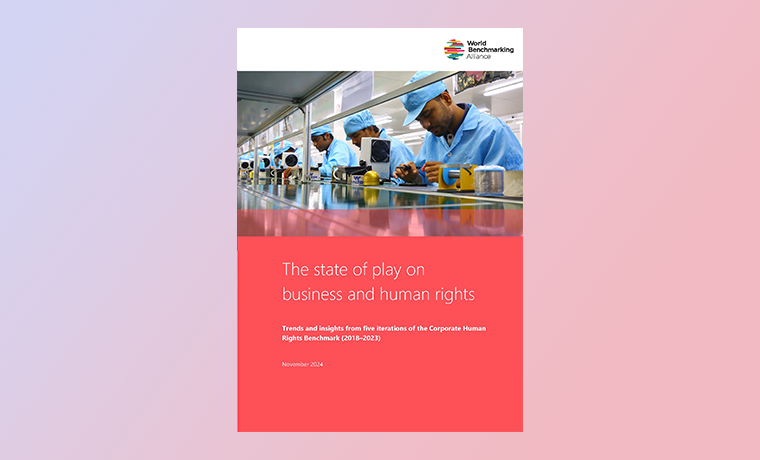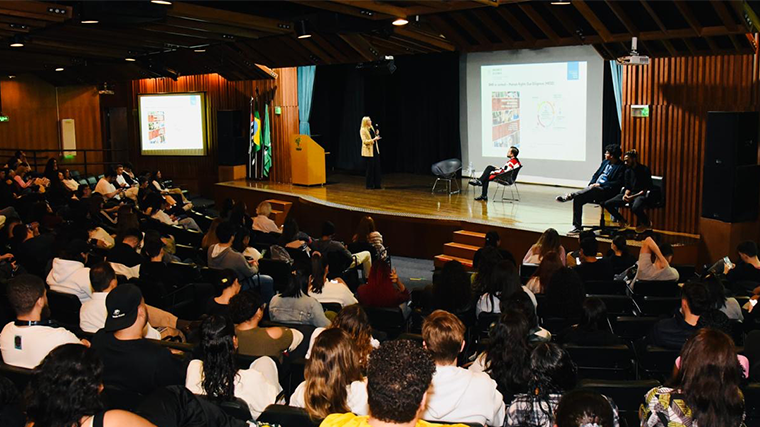Remarks by Michael Posner at the University of Michigan Ross School of Business, Ann Arbor, Michigan

October 10, 2014
Thank you Ravi for inviting me here and for organizing and hosting this timely and important meeting. And thank you President Schlissel for your kind introduction. It is great to be back at Michigan where I very happily spent my undergraduate years. Fortunately for me it was long before the Internet age and before social media was there to capture every adolescent adventure and misadventure. I can save some of that for the coffee break.
Actually I was fortunate to attend two of the world’s great public universities – Michigan and the University of California at Berkeley, where I got my law degree. I also taught for many years at two American law schools – Yale and Columbia – and I am now a proud member of the faculty at New York University’s Stern School of Business. At Stern, Sarah Labowitz and I have established the Center for Business and Human Rights, the first human rights center at a business school.
These experiences as a student and teacher, and now also as a parent, have led me to appreciate the extraordinary nature of our system of higher education. Our thousands of colleges and universities are the crown jewel of American democracy and the envy of the world. Each year, hundreds of thousands of students from all corners of the globe come here to enjoy the benefits of an American education. Many are among the best and brightest young minds in their own societies. Often they come because they are shut out of higher education at home.
They come here for the opportunity to get an American degree because it is the gold standard in higher education. According to the Times World University Rankings, seven of the top ten universities in the world are American. This is not to diminish the greatness of many excellent colleges and universities in other countries, but simply to observe that no other country devotes the resources we do to higher education or has a system of higher education with comparable breadth and depth. And even with the rising cost of college, our system is unique in that it reaches so many beyond the elite few. At a time when many people question American leadership in the world, the preeminent position of our colleges and universities is a sign of our continued success and a key to our future.
Colleges and universities also have become an economic force in American society, generating patents, commercially valuable intellectual property, and also building considerable endowments that help them maintain their standard of excellence. The combined endowments of American and Canadian colleges and universities total more than $450 billion dollars. If Harvard’s endowment were a hedge fund, it would replace Blackrock as the sixth biggest hedge fund in the world.
But with these resources comes responsibility. The soaring cost of higher education over the last 25 years means that many Americans struggle mightily to find the means to send their kids to school. As President Obama has said, “[W]e’ve got a crisis in terms of college affordability and student debt….The system’s current trajectory is not sustainable.” With the government’s help, academic and financial institutions need to do more to make college accessible and affordable to more Americans.
On the plus side, American colleges and universities are expanding their global reach. Nationally, about a quarter of the class of 2012 studied abroad. In recent years, several leading universities, including my own, have taken international education to the next level, opening campuses abroad. NYU has opened degree-granting campuses in Abu Dhabi and Shanghai. Georgetown, Carnegie Mellon, and Cornell have campuses in Doha, Duke recently established the Duke Kunshan University in China, and Yale has partnered with the National University of Singapore. These campuses are an innovative next step in the trajectory of American higher education, helping prepare students to meet the challenges of an increasingly globalized world.
But conducting university operations abroad presents new tests. The views of host governments on issues of academic freedom, free speech, labor rights, and the rights of LGBT people often are very different from our own and inconsistent with international human rights standards. It is up to leading American universities to come together to adopt common standards and procedures to respect fundamental rights and freedoms in their international operations.
Looking more broadly, what are the responsibilities of modern universities to the societies we serve? As we seek to change the future – through the minds of those we teach, the research we conduct, and the scholarship we publish – we also have responsibilities to respect human rights in the ways we operate.
What does this mean in practice? I know from long experience that when you say the words “human rights,” many people think the subject is worthy, but probably too difficult and expensive to implement in practice. I submit that American colleges and universities can lead the way in achieving practical, and even affordable, human rights results in three key areas: licensing, procurement, and investment.
University logoed goods are a source of immense pride and a sign of loyalty among students, parents, and alumni. I can’t count the number of Michigan t-shirts in my drawers and those of our three kids. These goods are a significant source of university revenue. The market for collegiate licensed merchandise was worth more than $4.5 billion last year.
Beginning in the 1990s when the anti-sweatshop movement took shape, students pushed university administrators and faculty to take a hard look at the conditions under which this merchandise is made. A number of people who will speak here today – Liz Kennedy, Marsha Dickson, Ben Hensler and Brian Delahoy – are veterans of intense debates on campuses about the role of universities in improving working conditions in factories to ensure that those Michigan t-shirts are not made in sweatshops. Ravi and others here have made Michigan a leader in those efforts.
We’ll hear more in today’s program about the work of the 200 or so universities that participate in the Fair Labor Association and the Worker Rights Consortium. An important premise of both of these efforts is the recognition that no one company – or university – can solve challenging labor rights issues alone. Companies need to work together, even with their fiercest competitors, when it comes to human rights.
But universities need to assume greater responsibility for labor rights in their licensing programs. Universities should screen potential suppliers for their capacity to manage labor rights challenges in their supply chains before licensing proposals are accepted and at the point of renewal. Schools like Michigan and UCLA are doing this, but more need to follow. Groups like the FLA and WRC can’t succeed if universities don’t assume greater responsibility and ownership for these issues.
I also want to comment on the broader subject of university procurement practices. From the food served in the dining hall to construction of new buildings and facilities, to the paper in office printers, the scope of university purchasing is tremendous. Each year, American colleges and universities spend hundreds of billions of dollars on commercial contracts for goods and services.
The scope of human rights challenges in this area is equally broad. The supply chains of universities touch labor rights in manufacturing, but extend to other issues and sectors as well. Oxfam’s Behind the Brands campaign rates food and beverage companies with respect to labor, property rights, and gender discrimination in agricultural supply chains. These are the companies that supply on-campus dining facilities. Conflict minerals can be found in the technology that is playing an increasing role in higher education. Another NGO, the Enough Project, is rating companies’ efforts to eliminate conflict minerals in their supply chains in the Democratic Republic of the Congo. And in their dealings with information and communication technology companies, universities should consider the scope and effectiveness of privacy policies and whether the companies they deal with are providing advanced customized technologies to aid repressive governments. If major American universities were to adopt uniform purchasing standards that addressed these issues they would help drive the debate nationally and globally on these important human rights subjects.
Many schools have systems in place that govern purchasing practices and dictate terms for contractors. For example, a number of schools include policies related to environmental sustainability or that encourage sourcing from minority- or women-owned businesses. But these efforts are uneven and uncoordinated, and more needs to be done.
The University of California system spends more than $7 billion each year on goods and services. It has an extensive and laudable commitment to what it calls “environmentally preferable purchasing goals.” And while the university’s supplier agreements require a certification that foreign made products will not be produced by forced or prison labor, it does not incorporate any of the other fundamental labor rights protections codified by the International Labor Organization. Why not?
Yale spends more than $1 billion a year and stipulates that its purchasing decisions are based on “a mix of social, environmental and economic considerations” which are spelled out in the university’s “Sustainable Procurement Standards Guide.” But the procurement guide offers little specific content relating to human rights and labor practices. Stanford’s guidelines are even narrower, focused almost exclusively on addressing “harmful effects on the environment.”
Michigan has adopted a program it calls “strategic sourcing” which calls for a fact-based approach aimed at consolidating the school’s purchasing power. Focused primarily on leveraging the university’s buying power to achieve cost savings, the school also applies what it calls the “total cost of ownership” model, which reflects customer needs, organizational goals, and total market conditions. But the human rights and labor dimension of purchasing practices is missing.
Current efforts to address these challenges are not commensurate with the responsibility of a sector that spends hundreds of billions of dollars annually. Why can’t major universities come together to develop common human rights standards and metrics for procurement that will maximize their leverage?
Finally, I want to add a third element to the mix, and consider the university as investor. Michigan’s endowment is $8.7 billion dollars, making it the eighth largest university endowment in the country. As I mentioned earlier, the combined endowments of American and Canadian universities now exceed $450 billion. Viewed from the perspective of the overall U.S. economy, with assets of over $200 trillion dollars, university endowments are modest. But if major universities came together to develop collective investment strategies aimed at advancing human rights, there is little doubt that they could have an impact.
Even in the mainstream investment world, long-term concerns about sustainability are starting to influence behavior. Just a few weeks ago, the Rockefeller family announced that their family foundations would divest from fossil fuels. Thus the nearly $900 million dollar legacy of Standard Oil is now committed to investments in clean energy and other sustainable technologies. Earlier this week, one of Australia’s largest pension funds announced that it will sell its holdings in coal companies, saying that climate change is an “unarguable scientific reality” and a “very real investment risk.”
These choices suggest a changing landscape. There now is a recognition by some in the investment world that the long-term health and stability of investments is connected to the long-term health and stability of the societies in which they operate and invest.
To be sure, the obligations of university endowments differ from those of family foundations or state pension funds. College and university endowments generate vital resources to support research, education, and scholarships. It is the generous tradition of philanthropy and financial stewardship within its academic institutions that has made the United States the leader in higher education.
Mindful of this, a number of universities have begun to adopt investment policies that incorporate environmental or social concerns into their investment analysis and decision-making. Harvard was the first U.S. university endowment to sign the UN Principles for Responsible Investment. But in resisting a campus campaign urging divestment from fossil fuels, Harvard President Drew Faust wrote last year, “[W]e should be very wary of steps intended to instrumentalize our endowment in ways that would appear to position the university as a political actor rather than as an academic institution.”
Academic institutions do hold a special place in our democracy and they are not political actors. But neither are they exempt from responsibility for the impact of their investments when it comes to the environment and human rights.
In May, Stanford took the decision not to invest in publicly traded coal mining companies. Michigan has twice divested stocks on the basis of social issues, from companies doing business in South Africa during Apartheid and more recently from tobacco companies. Yale has rejecting divestment from fossil fuels, but implementing new guidance for example on how it will vote on shareholder resolutions on climate change.
A number of other universities have constituted advisory committees to examine social and environmental issues in their portfolios and adopted statements on responsible investment policies. But too often the debate is purely reactive, focused on those issues that are the subject of student campaigns or wide media attention. These discussions are too narrowly focused on divestment in extreme cases as the only tool available to influence the behavior of companies in an endowment’s portfolio.
Instead there is a need for major universities to come together to develop a better coordinated, more creative and expansive approach to investments, an approach that yields solid financial returns while rewarding long-term sustainable business practices. Investment managers at universities and their investment management firms should build greater expertise in environmental and human rights issues. And university presidents should integrate the role of their schools both as thought and ethical leaders and as powerful economic actors.
In each of the areas I have mentioned there is a need for more research and scholarship. Through teaching, research and writing, the academic community has unique resources to examine the role of universities as licensors, purchasers, and investors.
So where do we go from here? First, with respect to the licensing issues that will be our primary focus today, universities should look to large American and European brands that have devoted significant resources to understanding and managing their supply chains. University leaders engaged on these issues should come together annually to address these challenges in a more comprehensive manner and to engage experts in these areas. It is not enough to simply join an organization like the FLA or WRC – universities must own the responsibility for ensuring respect for labor rights in their own licensing operations.
With respect to procurement, the footprints of the largest universities are similar to large, multifaceted companies that buy a wide range of products from around the world. Some companies have begun to screen their supply chains for issues such as child, forced, and migrant labor, as well as for risks of deforestation, land rights abuse, and conflict minerals. As a first step, universities commit to gather and publish comprehensive data that outlines both the scope of their procurement and the social and environmental risks that arise in these operations. With this data as a baseline, schools should organize a task force to develop university standards for social and environmental issues in procurement.
Finally, the time is ripe for major schools with the largest endowments to convene a meeting of their Chief Investment Officers to explore the collective actions they can and should be taking on social and environmental issues, consistent both with their duties as fiduciaries and their unique leadership role in advancing democratic principles and ideals.
When I served as our government’s point person on human rights in the State Department. I spent a lot of time in places that do not enjoy the tradition of open debate and academic freedom that are core attributes of our democracy. There is no doubt that even in these troubled times, America remains a beacon to people around the world. Our colleges and universities are the shining example of this truth. It will not be easy for our academic institutions to take a hard and sometimes critical look at their own role in the ongoing struggle for human rights. But I am confident that we are up to the task.
Thank you.
 Business Education
Business Education


